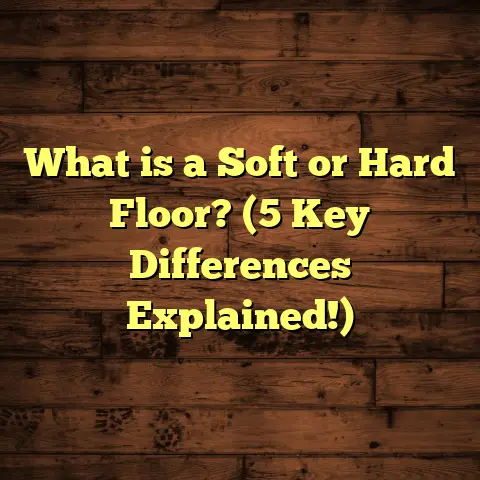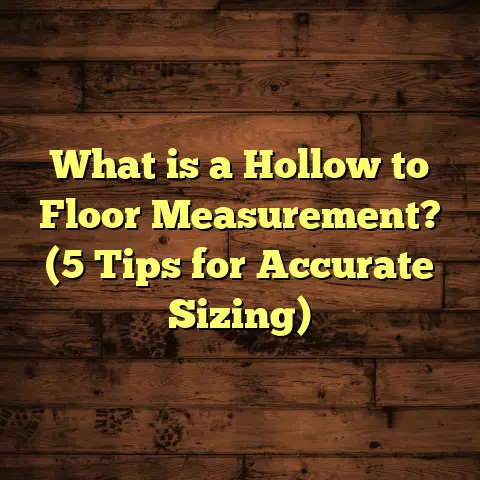What is Ground Floor Area? (5 Key Factors Explained!)
Spring is often the time when many of us start thinking about home improvements. The days get longer, the weather gets warmer, and there’s this natural impulse to freshen up our living spaces. For some, that means repainting walls or planting new flowers. For others—especially those who love home design or are planning major renovations—it’s about understanding the very basics of their home’s structure. One topic that frequently pops up during these projects is the concept of the ground floor area.
Maybe you’ve heard it mentioned by architects, builders, or real estate agents. Maybe you saw it in your property documents or planning permission papers but didn’t give it much thought. So what exactly does it mean? What is ground floor area, and why is it so important? Let me break it down for you in a way that’s easy to grasp but still detailed enough if you’re planning something big. I’ll also share some personal insights from years of working on flooring and building projects.
What is Ground Floor Area?
Defining the Ground Floor Area
At its core, the ground floor area is simply the total horizontal surface covered by the ground level of a building. Think of it as the footprint—the exact amount of land your house or building occupies on its base level. This includes all enclosed spaces on that first floor: bedrooms, bathrooms, kitchens, hallways, staircases, closets—everything under a roof and within walls.
But here’s an important detail: covered outdoor spaces like open balconies or patios are usually excluded from this measurement unless they’re fully enclosed. So if you have a porch with no walls, it typically doesn’t count as part of the ground floor area.
How This Differs From Other Measurements
You might be wondering how this differs from other common terms like total floor area or gross floor area. Here’s a quick rundown:
- Ground Floor Area: The footprint of the building on the land at the base level.
- Total Floor Area: The sum of all floors’ areas inside the building (ground floor + first floor + attic, etc.).
- Gross Floor Area: Usually includes all enclosed floor space including mezzanines and basements.
For example, if your house has two stories with 1,500 square feet on each floor, your total floor area is 3,000 square feet—but your ground floor area remains 1,500 square feet.
When I first started working on home renovation projects, this distinction was critical during budgeting and planning phases. Knowing exactly what ground floor area means can help you estimate costs accurately, understand property taxes better, and even figure out zoning or building regulations for your site.
Why Does Ground Floor Area Matter?
Understanding ground floor area isn’t just a technical exercise—it has real-world impacts on your project and budget.
Budgeting Construction Costs
When planning a renovation or new build, many costs depend on how much land you build on. Concrete slabs, foundations, flooring materials—all are tied to the ground floor footprint.
In one project I handled in 2022, a client wanted to add an extension. By knowing the existing ground floor area and the proposed addition’s size, we could create a detailed budget that included materials and labor. This avoided surprises later when ordering flooring or foundation materials.
Planning Permissions and Regulations
Local councils often regulate how much of your lot can be covered by buildings. This is where ground floor area becomes crucial.
For example:
- Some cities limit ground coverage to 30-40% of your lot size.
- If your property is 10,000 square feet, you might be restricted to building no more than 3,000–4,000 square feet on the ground level.
I once helped a client who wanted to build a garage but had to redesign because their original plan exceeded this limit. Knowing these numbers upfront saved time and money.
Property Valuation
Real estate agents and appraisers use ground floor area as one factor in valuing properties. Larger footprints often mean more usable land space and can affect pricing.
Maintenance Planning
A bigger ground floor means more space to maintain—flooring repairs, cleaning budgets, energy costs for heating and cooling.
Energy Efficiency
Building footprint interacts with energy use. A larger single-story home has more exterior wall exposure than a compact multi-story one with the same total living space. More exterior walls can mean higher heat loss in winter or heat gain in summer.
5 Key Factors Affecting Ground Floor Area
Let’s explore five important factors that influence or relate to ground floor area in any project.
1. Building Footprint Shape and Design
The shape of your building directly impacts its ground floor area.
A simple rectangular house is easy: length times width gives you your footprint quickly. But many homes aren’t simple rectangles—they have wings, L-shapes, courtyards, or irregular designs that make calculating ground floor area more complex.
In my experience working with modern homes featuring open-plan designs and multiple sections, breaking down each segment separately and summing them up works best. Architectural drawings or CAD software can help avoid errors here.
For example:
- A rectangular house measuring 40 ft by 30 ft has a ground floor area of 40×30=1,20040 \times 30 = 1,200 sq ft.
- Adding an L-shaped extension measuring 15 ft by 20 ft adds 15×20=30015 \times 20 = 300 sq ft.
- Total ground floor area: 1,200+300=1,5001,200 + 300 = 1,500 sq ft.
2. Inclusion of Covered vs. Uncovered Areas
Covered areas like garages or enclosed porches are counted in ground floor area calculations because they have roofs and walls.
Uncovered spaces like open decks or balconies without walls are usually excluded.
This distinction matters for permits and tax assessments.
I recall a project where a client had a large covered porch with screens but no full walls; this wasn’t included as part of the footprint because it was considered an outdoor space.
3. Local Building Codes and Zoning Restrictions
Local regulations often limit how much of your lot you can cover with buildings:
- Urban zones typically have stricter limits (25-35%).
- Suburban zones might allow higher coverage (up to 50%).
- Rural zones often have fewer restrictions but may have environmental rules.
These rules exist for reasons like drainage control, fire safety spacing between buildings, neighborhood aesthetics, and preserving green space.
Knowing these limits saves headaches later when submitting plans for approval.
4. Floor-to-Floor Height and Volume Considerations
Ground floor area only measures horizontal coverage but relates closely to vertical dimensions too.
A house with a large footprint but only one story uses more land than a multi-story house with similar total living space but smaller footprint.
This affects:
- Energy consumption (more roof surface equals more heat loss).
- Land use efficiency.
- Neighborhood density.
When advising clients aiming for energy efficiency or compact living solutions, I often suggest smaller footprints with vertical expansions instead of sprawling single-story designs.
5. Usable vs. Non-Usable Space
Not all spaces counted in ground floor area are truly usable living areas.
Basements aren’t included since they’re below grade; attics only count if fully finished and habitable.
Even within the ground floor:
- Utility rooms or mechanical spaces might be counted differently depending on purpose.
- Closets usually count as part of the footprint since they contribute to enclosed volume.
In appraisals or construction estimating, clarifying which spaces are included matters for accuracy.
A Closer Look at Data and Trends
Numbers help clarify how ground floor area plays out across different housing types.
According to recent U.S. Census Bureau data:
- The average new single-family home has a ground floor area between 1,200–2,000 sq ft.
- Urban homes tend toward smaller footprints (often under 1,000 sq ft) due to land scarcity.
- Suburban homes spread horizontally with footprints exceeding 2,000 sq ft in many cases.
- Zoning laws vary widely but generally limit lot coverage between 25–50% depending on location and density goals.
From my experience:
- Energy-conscious homeowners prefer compact footprints with multiple stories.
- Larger single-story homes cost more in materials per square foot than vertical designs because of larger foundations and roofing needs.
For flooring contractors like me:
- Larger footprints mean higher material quantities.
- Waste factors increase with complexity — irregular shapes cause more offcuts.
Understanding these trends helps homeowners balance size desires with budget and environmental considerations.
Personal Story: Measuring Ground Floor Area for My Own Home
When I bought my first house over a decade ago, understanding ground floor area became personal.
I wanted to add a sunroom but wasn’t sure if zoning rules allowed it.
One weekend armed with tape measures and architectural plans from my realtor’s office, I measured every room on the ground level—from living room to closets—then added up each section carefully.
The total came out around 1,500 sq ft on the ground floor.
After checking local zoning laws limiting building coverage to 50% on my plot size (about 6,000 sq ft), I confirmed there was room for expansion without needing extra permits.
That hands-on experience taught me how critical accuracy is when planning projects or ordering materials for flooring or foundations.
Even a few inches off can cause problems later when submitting permit applications or estimating costs.
How to Measure Ground Floor Area Accurately?
If you want to measure your own home’s ground floor area accurately:
- Gather Your Tools: Tape measure (25 ft+), laser distance measurer if available.
- Measure Each Room or Section: Include all enclosed spaces—bedrooms, kitchens, bathrooms.
- Don’t Forget Hallways & Stairwells: They count as part of the footprint.
- Exclude Open Outdoor Spaces: Porches without walls aren’t counted.
- Add Measurements Together: Sum all areas carefully.
- Double Check Your Numbers: Small errors add up quickly.
- Compare Against Lot Size: Calculate what percentage your footprint covers.
- Consult Local Zoning Rules: Ensure your plans fit regulations.
If you have architectural plans or blueprints handy (ask your builder or check public records), they can speed up this process dramatically and improve precision.
Common Mistakes People Make About Ground Floor Area
I’ve seen several repeated errors among homeowners and even contractors:
- Confusing total floor area with just ground floor area.
- Forgetting to include non-living spaces like garages or mechanical rooms.
- Overlooking local zoning restrictions on maximum lot coverage.
- Neglecting precision in measuring spaces—eyeballing leads to costly mistakes.
- Assuming outdoor covered spaces count as part of the footprint when they don’t.
Avoiding these mistakes helps keep projects on track financially and legally.
Ground Floor Area Impact on Flooring Choices and Costs
Since flooring is my specialty, here’s why knowing your exact ground floor area really matters:
- The bigger your ground floor footprint, the more flooring material you’ll need—whether hardwood planks or ceramic tiles.
- Flooring installation costs typically range from $3 to $12 per sq ft, depending on material quality and installation complexity.
Let’s say you’re installing engineered hardwood over a 1,800 sq ft ground floor.
Add a typical waste factor of about 7% (to account for cuts and mistakes): 1,800×1.07=1,926 sq ft1,800 \times 1.07 = 1,926 \text{ sq ft}
So you’d order approximately 1,926 sq ft of flooring material—not just 1,800—to ensure coverage without delays or shortages.
Ordering too little means costly rush orders; ordering too much ties up capital unnecessarily.
Case Study: Renovation Project Ground Floor Area Analysis
Here’s an example from a project I recently worked on renovating a mid-century home:
- Original ground floor measured 1,600 sq ft.
- Client wanted to push out an additional 200 sq ft for kitchen/living room expansion.
Calculating new footprint: 1,600+200=1,800 sq ft1,600 + 200 = 1,800 \text{ sq ft}
Their lot size was half an acre (~21,780 sq ft).
Zoning allowed maximum lot coverage of 50%, meaning: 0.5×21,780=10,890 sq ft0.5 \times 21,780 = 10,890 \text{ sq ft}
Our new footprint at 1,800 sq ft was well within limits—which simplified permit approval significantly and kept construction costs manageable.
Flooring materials were ordered accordingly with an additional waste factor included in estimates.
How Ground Floor Area Influences Property Value
In real estate markets:
- Larger footprints translate into higher property value particularly in suburban neighborhoods where land use matters more.
- Buyers often associate bigger footprints with easier access to outdoor amenities like patios or gardens without climbing stairs.
Urban buyers may prefer smaller footprints but taller buildings offering flexibility on smaller plots due to land scarcity.
Knowing your home’s footprint helps in negotiations whether buying or selling.
Ground Floor Area & Environmental Considerations
Environmental impact links closely to building footprint:
- Larger footprints increase impervious surfaces blocking rainwater absorption—raising runoff risk.
- More foundation means more construction materials impacting carbon footprint.
Sustainable building practices encourage minimizing footprints while maximizing vertical space for energy efficiency and environmental preservation.
From my observations working with eco-conscious clients:
- Smaller footprints can reduce heating/cooling loads due to less exposed wall surface.
- Green roofs or rooftop gardens can offset larger footprints’ environmental effects by adding insulation and absorbing rainwater.
What If You Need More Space Without Increasing Ground Floor Area?
If you need extra space but want to keep your footprint small:
- Consider building up (adding floors).
- Use basement levels if zoning allows (though basements don’t count toward ground floor area).
- Utilize attic conversions for extra rooms.
Each option comes with cost implications but offers ways to maintain compliance with zoning while expanding usable space.
Tools & Technology for Measuring Ground Floor Area Precisely
Technology makes measurement easier than ever:
- Laser distance measurers provide quick accurate lengths in large spaces.
- Smartphone apps now offer augmented reality-based measuring tools for rough estimates.
- CAD software helps architects calculate exact footprints from digital plans.
If you’re serious about renovations or buying property soon:
Getting professional measurements using advanced tools can save money long term by ensuring accuracy in planning permits and materials ordering.
How I Use Ground Floor Area Data in My Flooring Business
From ordering materials to scheduling installations:
Knowing exact dimensions upfront lets me:
- Calculate precise quantities avoiding waste or shortage.
- Schedule labor efficiently based on project size.
- Advise clients realistically about costs tied closely to footprint size.
For example:
On one project with an irregular L-shaped layout totaling roughly 2,200 sq ft footprint:
We broke down measurements into sections for accurate material cutting plans which saved over $1,000 in wasted flooring material compared to ordering flat bulk amounts without detailed calculations.
FAQs About Ground Floor Area
Q: Does basement count toward ground floor area?
A: No. Basements are below grade and not part of the horizontal footprint measurement even though they add usable space inside the home.
Q: What about garages?
A: If attached and enclosed with walls/roof at ground level—they count toward ground floor area. Detached garages usually do not unless connected by covered walkways fully enclosed.
Q: How do porches factor in?
A: Open porches without walls typically don’t count; covered porches fully enclosed do count if they have walls/roof enclosing them at grade level.
Q: Can I increase my ground floor area after buying?
A: Usually yes—but check local zoning laws first to avoid penalties or forced removal later. Permits are almost always required for additions affecting footprint size.
Final Thoughts From My Experience
Ground floor area is one of those foundational measurements that impacts everything from design possibilities to budget accuracy in home projects.
Measuring it carefully early helps avoid costly mistakes later whether you’re adding floors, renovating kitchens, installing flooring materials, or applying for permits.
I always recommend anyone considering remodeling or buying property take time measuring their home’s footprint or consulting professionals who understand local regulations thoroughly.
Got questions about your own home’s footprint? Feel free to ask—I’m here to help!





